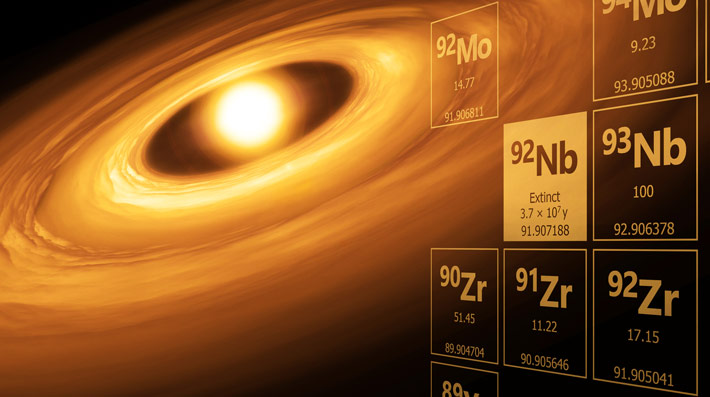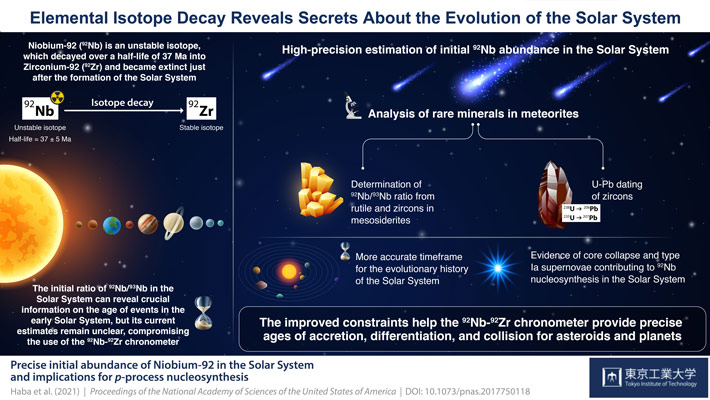Evidence of extinct radionuclides like Niobium-92, which formed before the birth of our Solar System, has been identified in meteorites. Using this evidence, scientists at Tokyo Institute of Technology (Tokyo Tech) ETH Zürich, National Institute of Polar Research, and Konkoly Observatory pinpointed the initial abundance of Niobium-92 by studying rare rutile and zircon minerals from meteoritic fragments. This allowed them to date events in the early Solar System with greater precision and provide constraints on the production of Niobium-92 in different types of supernova explosions.

When an element has a surplus of protons or electrons, it becomes unstable and sheds these additional particles as radiation until it reaches stability. Niobium-92 (92Nb) is an unstable isotope, which decays to the stable Zirconium-92 (92Zr) over time and has a short half-life of 37 million years. For this reason, it became extinct shortly after the formation of the Solar System. Today, only enrichments in the daughter isotope, 92Zr, bear testimony to the once-alive 92Nb.
Scientists have been able to determine the ages of the events in the early Solar System, somewhere starting around 4.567 billion years ago, by measuring the decay of various elements and their isotopes. However, the 92Nb-92Zr chronometer is limited because of the lack of concrete information regarding the amount of 92Nb that was present at the birth of the Solar System. This compromises its use for dating and the determination of the production of such atoms in stellar environments. A research team led by Assistant Professor Makiko K. Haba of Tokyo Institute of Technology (Tokyo Tech) significantly improved this chronometer by establishing a more accurate timeframe for the evolutionary history of the Solar System as well as providing a better understanding of the production sites of such rare isotopes.
Prof. Haba and her team recovered rare zircon and rutile minerals, which are considered most suitable for the 92Nb estimation, from meteorites that were fragments of the protoplanet Vesta. With these minerals, they were able to establish the 92Nb abundance when these meteorites had formed. Then, with the widely used uranium-lead dating technique used to confirm their age, the team was able to precisely calculate the original 92Nb abundance at the time of Solar System formation.
With this new information, the team enhanced the precision of the existing 92Nb-92Zr chronometer. Commenting on the significance of the team’s findings, Prof. Haba states, “This significantly improved precision makes the 92Nb-92Zr chronometer a powerful tool for providing precise ages of accretion, differentiation, and collision for asteroids and planets that took place in the first tens of millions of years after the formation of the Solar System.”
An additional benefit of the improved initial 92Nb abundance is that it provides constraints on where such isotopes are formed. This, in turn, gives us a better idea of where the material from which our Sun and the planets are formed originated. The team’s new model indicates that the inner Solar System is more heavily influenced by material ejected in our Milky Way Galaxy by type Ia supernovae, where two orbiting stars interact with each other before releasing ejecta of stellar material. Conversely, the outer Solar System was primarily fed by a “core-collapse” supernova probably within the stellar nursery where the Sun was born, where a massive star collapsed in on itself and exploded violently.
No doubt, the “stellar” discoveries of Prof. Haba and her team have extremely important and wide-ranging implications for research in the field of geochemistry at large!









